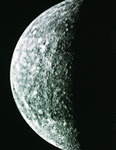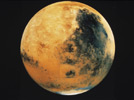High School & Beyond
Native American Skylore (Taped)
Native American Skylore is a look at the nighttime sky, the seasons, the phases of the Moon, and the motions of the planet Venus as seen through the eyes of Native Americans. Included are such topics as Serpent Mound, Native American myths and legends, and how ancient records are still useful to astronomers today.
Ancient Worlds (Live)
 Ancient Worlds looks at
the barren, rocky worlds of the Solar System: Mercury and our Moon. This program looks
at the evolution of these worlds, and also at comets and
meteors as clues to the early solar system. The program also discusses the birth of
our star, the Sun. While Ancient Worlds can be
customized to any age, it is strongly recommended that students be previously exposed
to Journey Through the Solar System or its
equivalent.
Ancient Worlds looks at
the barren, rocky worlds of the Solar System: Mercury and our Moon. This program looks
at the evolution of these worlds, and also at comets and
meteors as clues to the early solar system. The program also discusses the birth of
our star, the Sun. While Ancient Worlds can be
customized to any age, it is strongly recommended that students be previously exposed
to Journey Through the Solar System or its
equivalent.
The Weather Out There (Taped)
Weall know how difficult the weather can be. But did you ever wonder what causes it? In this program, your group will learn why we have weather on the Earth and what the weather would be like if we lived on other planets. Bring your group to experience twisters here on the Earth, dust storms on Mars, and acid rain on Venus!
Celestial Motions (Live)
 Celestial Motions
fully utilizes the capabilities of the planetarium's central star projector. Your
students will be introduced to the daily, annual, and
precessional motions of the Earth; the reasons why we have seasons and eclipses; and
why the Moon (and some of the planets!) go through phases.
The unique environment of the planetarium is virtually essential in teaching these
concepts. We strongly advise that all students be exposed to
this program, or a similar one, at least twice during their academic careers. Get
program follow-up activities (pdf).
Celestial Motions
fully utilizes the capabilities of the planetarium's central star projector. Your
students will be introduced to the daily, annual, and
precessional motions of the Earth; the reasons why we have seasons and eclipses; and
why the Moon (and some of the planets!) go through phases.
The unique environment of the planetarium is virtually essential in teaching these
concepts. We strongly advise that all students be exposed to
this program, or a similar one, at least twice during their academic careers. Get
program follow-up activities (pdf).
Skywatchers of Africa (Taped)
Since the beginning of human experience, the people of Africa have used their knowledge of the sky to meet their physical needs for survival, and for navigation. They have used the sky as a guide to build their societies, and for calendar making. The sky also shapes their spiritual lives; playing an important role in many ceremonies and providing clues to the deepest human questions. Skywatchers of Africa, produced by the Adler Planetarium, examines several cultures, past and present, from across the African continent. It shows how these examples are similar to the experience of people all around the world.
Jovian Worlds (Live)
Jovian Worlds examines the four massive gaseous planets of our Solar System: Jupiter, Saturn, Uranus, and Neptune. This program discusses these worlds, their satellites, and their rings. It also contains the latest information on Pluto and the possibility of trans-Plutonian worlds. Once again, we strongly recommend that students be previously exposed to Journey Through the Solar System, or its equivalent, to gain the maximum potential benefit from this program.
The Dawn of Astronomy (Taped)
 Journey back in time to discover
why the pyramids of Egypt and Stonehenge in England were built. Your students will
see the splendor of the newly raised pyramids and watch as the
Sun rises over the Heel Stone at Stonehenge. The incredible achievements of early
man in measuring the length of the year, developing a concept
of the Zodiac, and predicting exactly how the Sun and Moon move in the sky are celebrated
in The Dawn of Astronomy.
Journey back in time to discover
why the pyramids of Egypt and Stonehenge in England were built. Your students will
see the splendor of the newly raised pyramids and watch as the
Sun rises over the Heel Stone at Stonehenge. The incredible achievements of early
man in measuring the length of the year, developing a concept
of the Zodiac, and predicting exactly how the Sun and Moon move in the sky are celebrated
in The Dawn of Astronomy.
The Stargazer (Taped)
The Stargazer is an exciting program produced by the Great Lakes Planetarium Association that explores how imagination, curiosity, & scientific thought have allowed us to begin to understand some of the deepest mysteries of the universe. The Stargazer is narrated by Nichelle Nichols, "Star Trek’s" Lt. Uhura. While she journeyed to the stars in TV and movies, in this planetarium program she shows us how we can "visit" the stars with telescopes and our minds. See how this program meets science education standards.
Women in Astronomy (Taped)
Women in Astronomy discusses the contributions to astronomy made by women. Often the names of women in astronomical history are left out. This program points out the rich history of women in this scientific field. Students will learn that many important discoveries - discoveries without which astronomy might be decades behind - were made by dedicated women.
Where Have all the Martians Gone??
 For over a hundred years, we have
been pondering about whether or not there is life on Mars. Our recently updated program,
Where Have all the Martians Gone??, examines
our ever-changing understanding of the "red planet," and whether or not it has --
or ever had -- life on it. This program also looks at the
recent discoveries made by the Mars Global Surveyor, and outlines our planned missions to Mars, the most intriguing of all the planets.
For over a hundred years, we have
been pondering about whether or not there is life on Mars. Our recently updated program,
Where Have all the Martians Gone??, examines
our ever-changing understanding of the "red planet," and whether or not it has --
or ever had -- life on it. This program also looks at the
recent discoveries made by the Mars Global Surveyor, and outlines our planned missions to Mars, the most intriguing of all the planets.
Serpents of the Sun (Taped)
Produced by the Ward Beecher Planetarium and the Boonshoft Museum of Discovery in Dayton, Ohio, Serpents of the Sun examines the rich cultures and astronomical heritages of several Native American civilizations that made Ohio their homes. This program examines several burial mounds in central and southern Ohio and SunWatch, a Native American Stonehenge, located near Dayton, Ohio.
The Lives & Deaths of Stars (Live)
The Lives & Deaths of Stars introduces stellar evolution and the origin of the elements from which we are made. It is exciting to think that the carbon in our bodies was once inside a star, and came to us through a stupendous supernova explosion. This program also covers the sizes and colors of the stars.
In the Beginning (Live)
 In the Beginning
discusses the overall arrangement of matter into planets, stars, galaxies, clusters
of galaxies, and the universe; and how we think it got that
way. We cover the Big Bang and the expanding universe, concepts of time and space,
and what will happen in the next 20 billion years. This
program is best for showing students the process of science, because it presents many
ideas that are still uncertain or only questions.
In the Beginning
discusses the overall arrangement of matter into planets, stars, galaxies, clusters
of galaxies, and the universe; and how we think it got that
way. We cover the Big Bang and the expanding universe, concepts of time and space,
and what will happen in the next 20 billion years. This
program is best for showing students the process of science, because it presents many
ideas that are still uncertain or only questions.
Navigating with Lewis & Clark (Taped)
How did Lewis and Clark know where they were when they were in the middle of nowhere? Find out when you see this planetarium program. You’ll learn how Lewis and Clark used the positions of the Sun and other celestial objects to estimate where they were. And you’ll see how you can do it, too.
Is There Anybody Out There?? (Taped)
One of the most basic questions ever asked by human beings is: Is There Anybody Out There?? The newest program produced by the Ritter Planetarium staff is about the Search for Extra-Terrestrial Intelligence, or SETI. It looks at how astronomers search for alien civilizations, where they think they might be found, and what they think their odds of success are. Is There Anybody Out There?? shows that it isn’t always the answers that are important in science. What is important is asking the questions.
See how these programs meet Science Education Standards.


